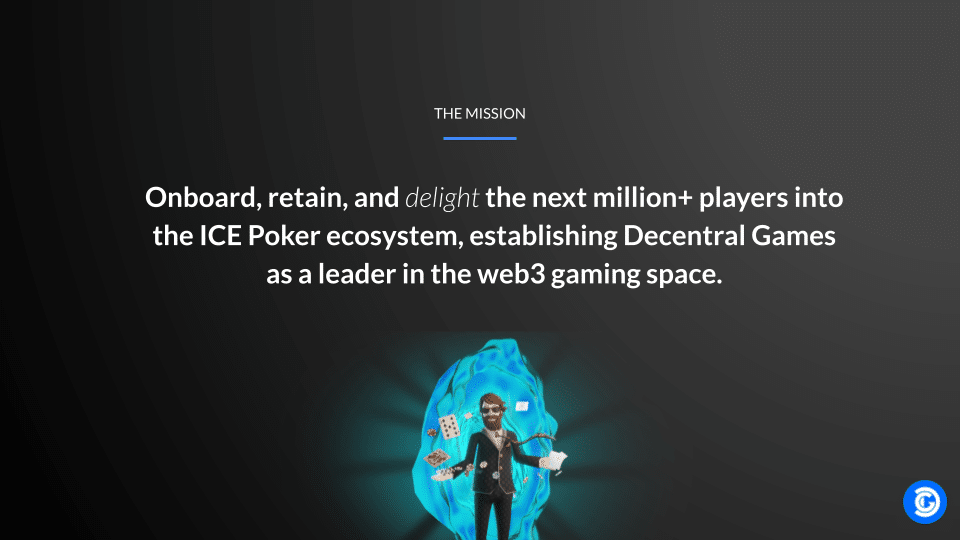Hey, Matt here 👋
As we look to double down on our investment in driving new user growth into the Decentral Games ecosystem, I wanted to share a complete overview of our marketing approach with the community.
You can also view the full strategy deck or watch me talk through it below.
(The strategy deck is also translated in Spanish and Korean.)
Arming the wider community with this context should help mobilize everyone in directing their energy to support our collective growth in a way that aligns with the strategy we’ve laid out.
Let’s begin by outlining the mission we’re on:
“To onboard, retain, and delight the next million+ players into the ICE Poker ecosystem, establishing Decentral Games as a leader in the web3 gaming space.”
To achieve our long-term mission, we’ll be investing heavily in the following three areas:
- Growth through new user acquisition: ICE Poker players are at the center of our universe. To grow, we need to attract a steady flow of new ones.
- Building a compelling story around our brand: Without a compelling story, Decentral Games is just another web3 protocol. We must stand out from the rest.
- Community growth and engagement: Governance participation and community advocacy need to be rewarded for us to grow to the next level.
Growth Through New User Acquisition
Growing the number of players within ICE Poker is at the top of our list.
It’s what powers our ecosystem flywheel, and that flywheel’s a powerful one once it starts spinning.
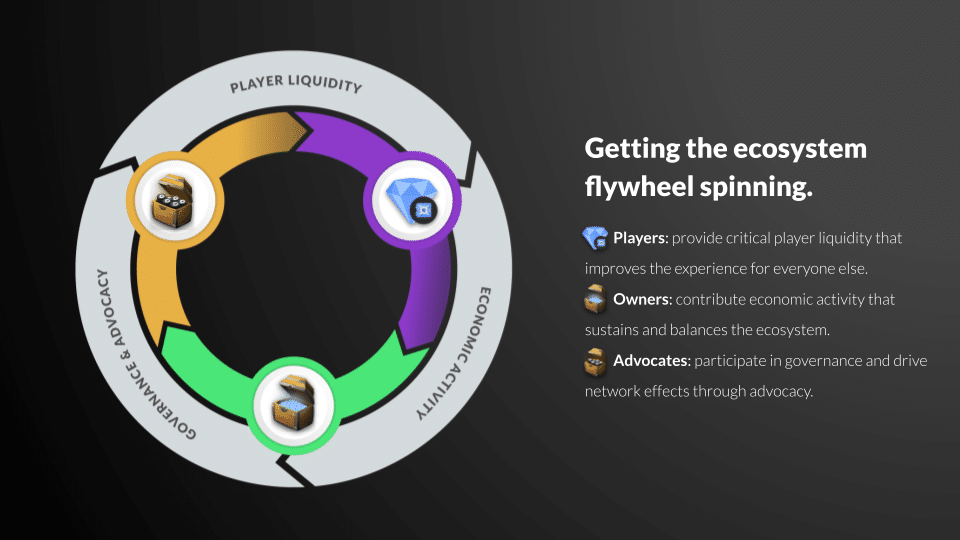
Before I dive into our channel strategy, it’s important to understand who we’re targeting when we talk about acquiring new users.
There’s still an awful lot of friction in the signup process which means targeting non-crypto natives will be both extremely costly and have a low conversion rate. For this reason, we’ll focus our attention on acquiring web3 natives in the short term.
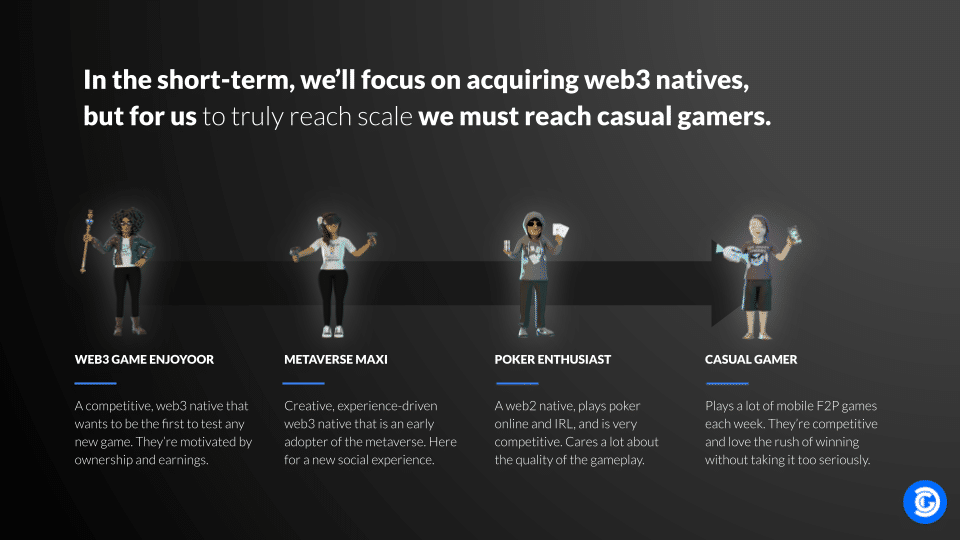
Here’s an overview of the four personas that we’ve divided our target audience into:
- The “Web3 Game Enjoyoor”: A competitive, web3 native that wants to be the first to test any new game. They’re motivated by ownership and earnings.
- The “Metaverse Maxi”: Creative, experience-driven web3 native that’s an early adopter of the metaverse. Here for a new social experience.
- The “Poker Enthusiast”: A web2 native, plays poker online and IRL, and is very competitive. Cares a lot about the quality of the gameplay.
- The “Casual Gamer”: Plays a lot of mobile F2P games each week. They’re competitive and love the rush of winning without taking it too seriously.
For us to truly reach scale, we must reach casual gamers. That said, we’re not quite ready to go all-in on that group just yet and there’s still a large pool to tap into within the web3 space.
The Starting Point
The first priority of our user acquisition efforts is to establish some benchmarks for our customer acquisition cost (CAC).
We’ll do this through some exploratory display advertising campaigns. It’s worth calling out that our CAC will be particularly high at this stage due to the following reasons:
- We’re beginning our advertising campaign during one of the most expensive times of the year (the run-up to Black Friday/Cyber Monday and Christmas).
- This is our first chance to test which ad creative and copy resonates with our target audience.
- Advertising campaigns require time for the algorithms to optimize ad delivery.
With that in mind, we’re allocating a much smaller budget to get some data we can build on. The goal here is not to bring in tons of new users at a low CAC (as much as that would be a wonderful outcome); the goal is to establish a benchmark that we can improve upon and use to calculate ROI across other channels.
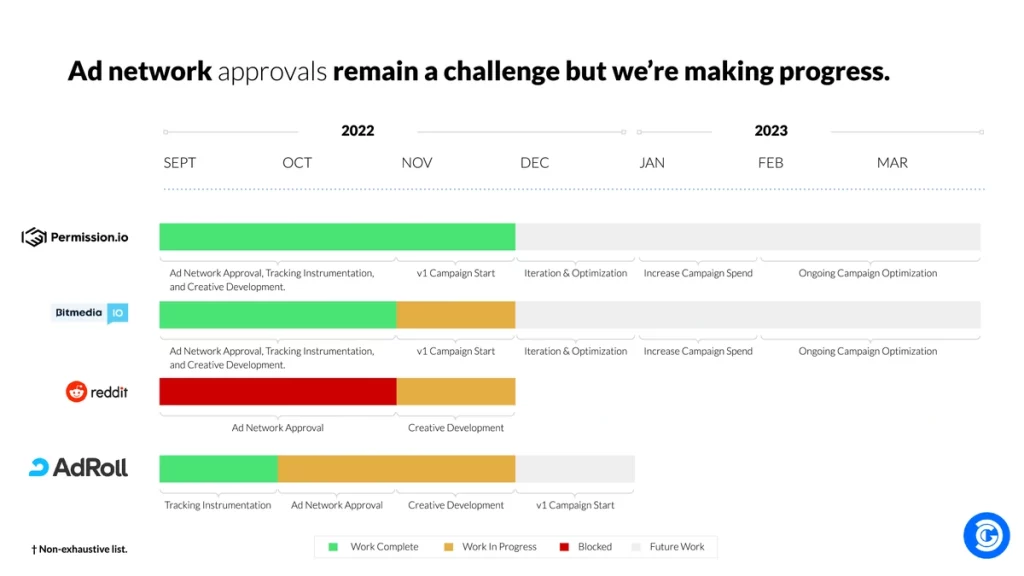
The above visual outlines a non-exhaustive list of ad campaigns that we’re launching. As I mentioned previously, our focus will be on targeting web3 users so we’ll be working with some specialist ad networks that will exclusively target individuals with wallets. From there, we’ll expand our reach.
A Tailored Growth Strategy
Outside of our display advertising, we’ll be investing resources in a number of other channels that will be part of a tailored growth strategy for acquiring each of our different ecosystem participants:
- Delegated players
- Guild owners
- SNG players
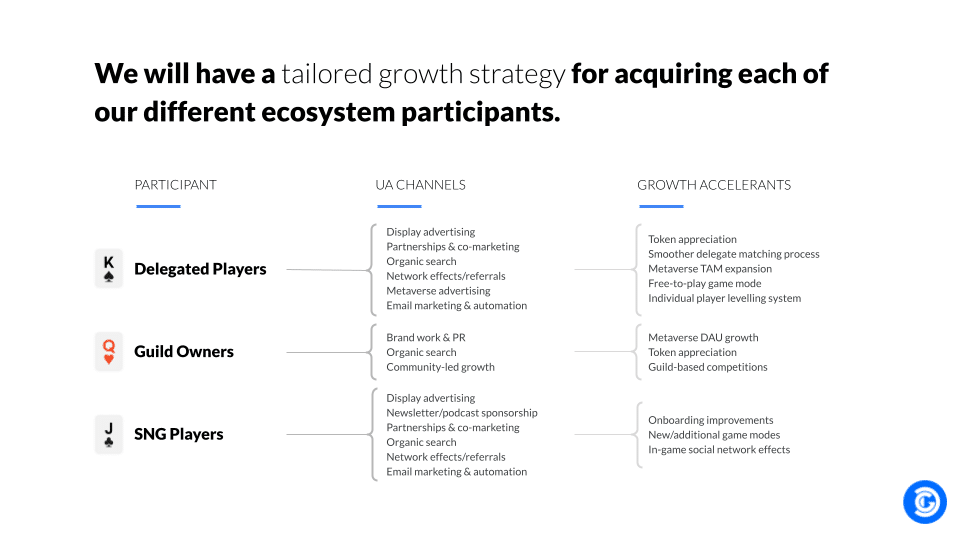
The visual above shows some of the different channels we’ll be using to acquire each participant, with SNG players and delegated players being the primary focus.
Product-led growth, the motion of stimulating new user growth from features built into the product itself, will become an increasingly important lever for us to pull on. The marketing and product team will be working hand-in-hand to deliver a great user experience within the game, but one that also promotes network effects.
Our goal is to make ICE Poker a truly social experience. It should recreate the same intimate, social experience that you feel playing against your buddies at home.
To achieve this, we’ll build features that deliver against the following three attributes:
- Progression: Provides the player with a sense of progress and accomplishment within the game, and a desire to continue.
- Socialization: Forms connections with other players during gameplay and cements a feeling of community.
- Simplicity: The feature doesn’t complicate gameplay unnecessarily and in many cases, simplifies it.
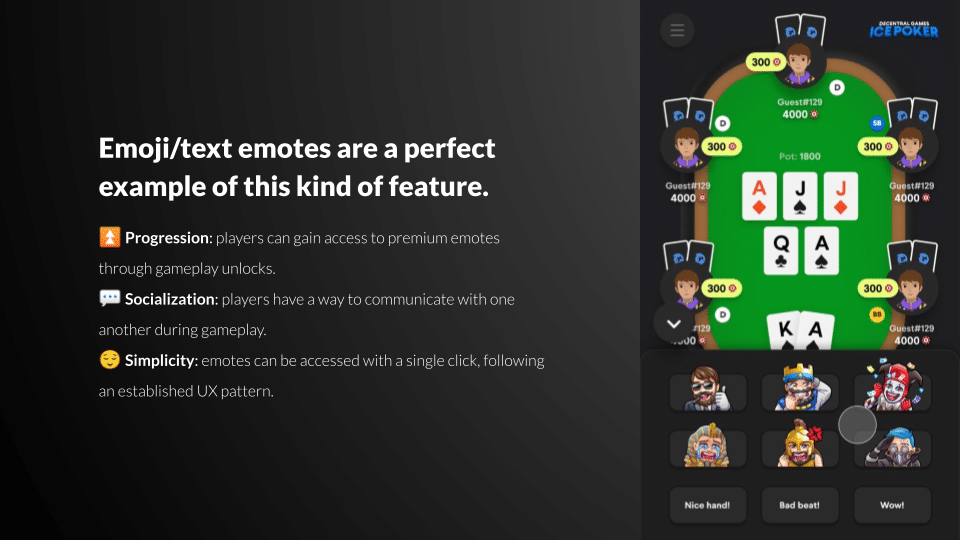
Building a Compelling Brand Story
Without a compelling story, Decentral Games is just another web3 protocol. We need to stand out from the rest.
The challenge we’ve historically faced is that our positioning hasn’t always been very clear. The consistently changing narrative in the web3 gaming space further muddies the water here, which means it’s more important than ever that we have a compelling story to tell.
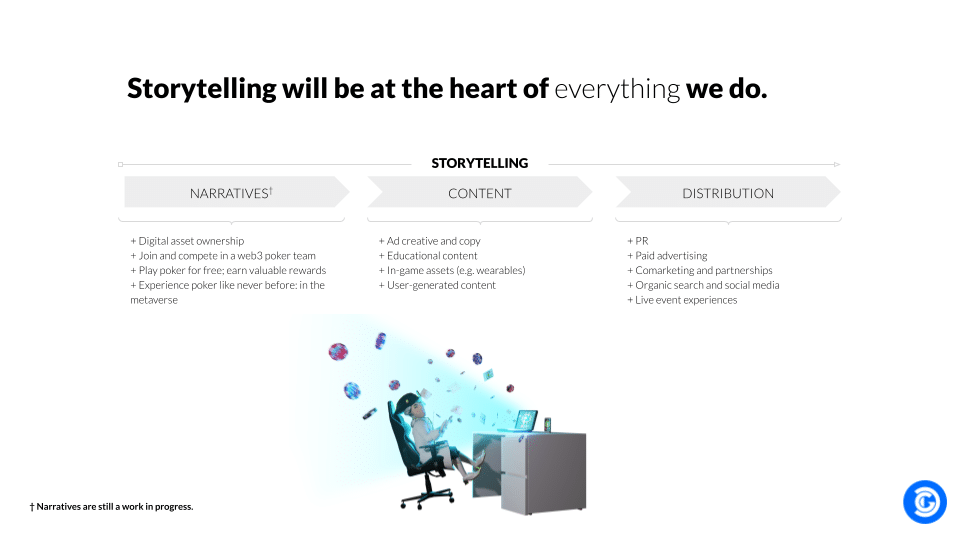
We’re still finalizing some of the narratives we’ll be pushing, but our advertising campaigns will give us some good direction on its effectiveness. What’s most important is that we have consistent storytelling threaded through all of the content we produce.
Brand Content and Distribution
Much of the work we’ll do on our brand will have either direct or indirect benefits to our user acquisition efforts, but we’ll be very selective with where we allocate resources here.
Sorry, no Super Bowl ads just yet!
One of the larger investments we plan to make will be in education.

People search Google for ways to learn about poker or improve poker skills in excess of 100,000 times every month. That’s a sizeable volume of search demand that we could tap into if we build educational content that solves these pain points and ranks well in search engines.
Not only that but this content will be a valuable resource for our existing players, helping them to get better at poker will enable them to see more progression within ICE Poker and lead to greater retention. For those consuming this content that aren’t already players, it will serve as a new funnel to convert them into our game(s).
Community Growth and Engagement
Governance participation and community advocacy need to be rewarded for us to grow to the next level. This will be our third and final investment area.
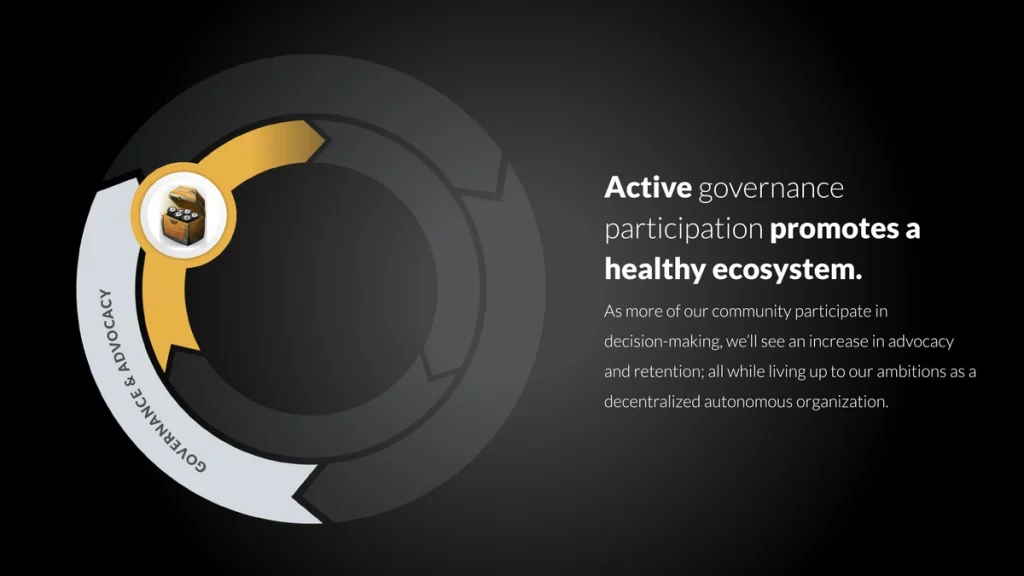
It can’t be overstated how important our community is. It’s the greatest asset we have.
Not only does the community contribute to the direction and decision-making of the ecosystem, but it consists of our biggest advocates.
The loyalty and advocacy of the community must be encouraged and rewarded.
We’ll be exploring different ways to operationalize advocacy that can then feed into new user growth. Some of these ideas include referral programs, bounties, and quests. On top of that, we’ll be doing more to reward our most loyal community members.
Our most devoted cohort of users are our Crown and Scepter holders. They need more exclusive benefits. This will be an area we’ll improve on.
Outside of advocacy, governance participation will be another focal point for the team. The more we lower the barriers to governance participation while increasing education on its importance, the faster we’ll grow.
Measuring Our Impact
Here’s how we’ll measure the impact of our work across each of our three investment areas.
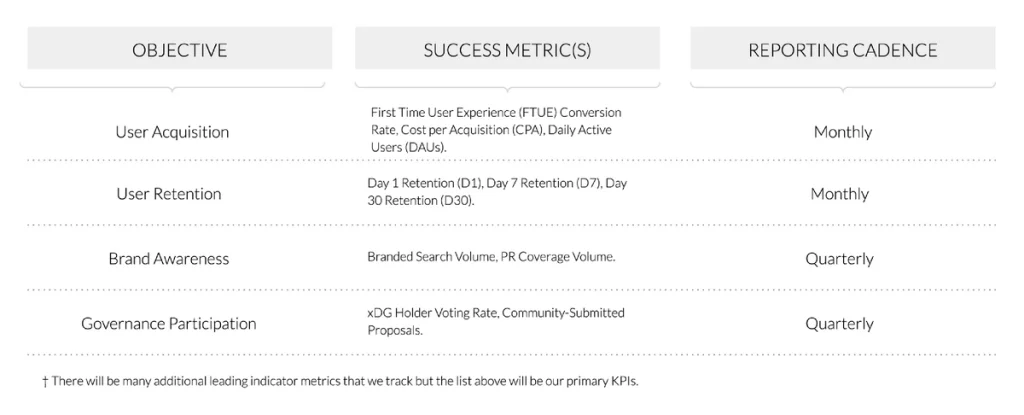
As you can see, there are multiple metrics that we’ll track against each of the four objectives. It’s worth noting that there will be plenty of additional metrics we’ll track, but many of these will be leading indicators of our primary success metrics.
If you’d like to see a more detailed overview of our marketing strategy, click here to view the entire strategy deck.
